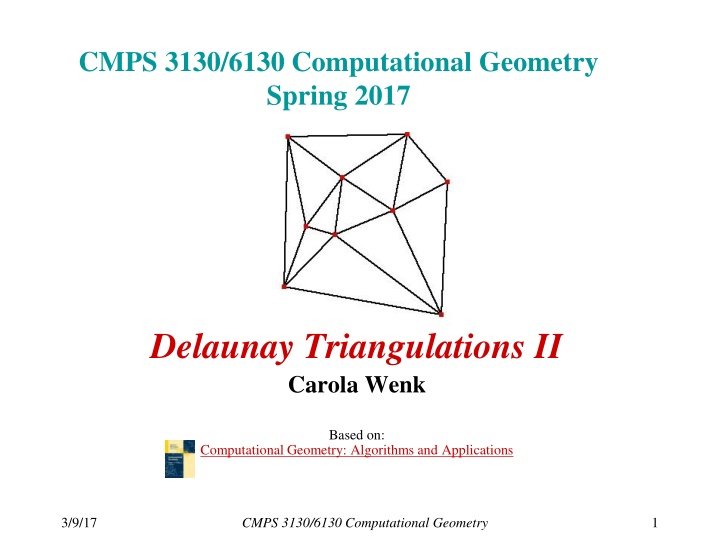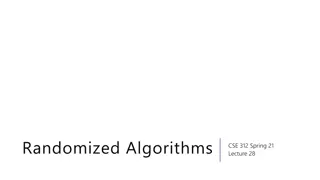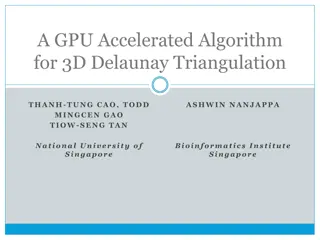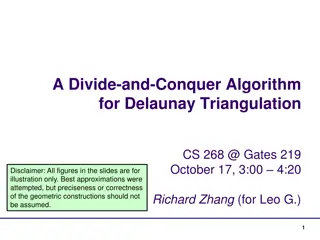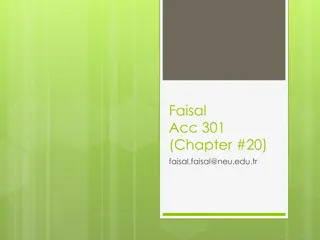Randomized Incremental Construction of Delaunay Triangulations II
This presentation delves into the computational geometry topic of Delaunay Triangulations, focusing on the Randomized Incremental Construction method. The process involves incrementally inserting points into a large triangle, flipping edges to ensure legality, and storing historical triangle data for efficient point location. The content also explores the DT and 3D.CH Theorem, discussing the orthogonal projection onto planes and paraboloids. Detailed images and pseudo-code are included to aid in understanding the concepts presented.
Download Presentation

Please find below an Image/Link to download the presentation.
The content on the website is provided AS IS for your information and personal use only. It may not be sold, licensed, or shared on other websites without obtaining consent from the author.If you encounter any issues during the download, it is possible that the publisher has removed the file from their server.
You are allowed to download the files provided on this website for personal or commercial use, subject to the condition that they are used lawfully. All files are the property of their respective owners.
The content on the website is provided AS IS for your information and personal use only. It may not be sold, licensed, or shared on other websites without obtaining consent from the author.
E N D
Presentation Transcript
CMPS 3130/6130 Computational Geometry Spring 2017 Delaunay Triangulations II Carola Wenk Based on: Computational Geometry: Algorithms and Applications 3/9/17 1 CMPS 3130/6130 Computational Geometry
Randomized Incremental Construction of DT(P) Start with a large triangle containing P. Insert points of P incrementally: Find the containing triangle Add new edges Flip all illegal edges until every edge is legal. 3/9/17 CMPS 3130/6130 Computational Geometry 2
Randomized Incremental Construction of DT(P) pr pr An edge can become illegal only if one of its incident triangles changes. Check only edges of new triangles. Every new edge created is incident to pr. Every old edge is legal (if pr is on on one of the incident triangles, the edge would have been flipped if it were illegal). Every new edge is legal (since it has been created from flipping a previously legal edge). flip shrink circle empty circle Delaunay edge pr pr pr 3/9/17 CMPS 3130/6130 Computational Geometry 3
Pseudo Code 3/9/17 CMPS 3130/6130 Computational Geometry 4
History The algorithm stores the history of the constructed triangles. This allows to easily locate the triangle containing a new point by following pointers. Division of a triangle: Store pointers from the old triangle to the three new triangles. Flip: Store pointers from both old triangles to both new triangles. 3/9/17 CMPS 3130/6130 Computational Geometry 5
DT and 3D CH Theorem: Let P={p1, ,pn} with pi=(ai, bi,0). Let p*i =(ai, bi, a2i+ b2i) be the vertical projection of each point pi onto the paraboloid z=x2+ y2. Then DT(P) is the orthogonal projection onto the plane z=0 of the lower convex hull of P*={p*1, ,p*n} . P* P Pictures generated with Hull2VD tool available at http://www.cs.mtu.edu/~shene/NSF-2/DM2-BETA 3/9/17 CMPS 3130/6130 Computational Geometry 6
DT and 3D CH Theorem: Let P={p1, ,pn} with pi=(ai, bi,0). Let p i =(ai, bi, a2i+ b2i) be the vertical projection of each point pi onto the paraboloid z=x2+ y2. Then DT(P) is the orthogonal projection onto the plane z=0 of the lower convex hull of P ={p 1, ,p n} . Pictures generated with Hull2VD tool available at http://www.cs.mtu.edu/~shene/NSF-2/DM2-BETA 3/9/17 CMPS 3130/6130 Computational Geometry 7
DT and 3D CH Theorem: Let P={p1, ,pn} with pi=(ai, bi,0). Let p i =(ai, bi, a2i+ b2i) be the vertical projection of each point pi onto the paraboloid z=x2+ y2. Then DT(P) is the orthogonal projection onto the plane z=0 of the lower convex hull of P ={p 1, ,p n} . Pictures generated with Hull2VD tool available at http://www.cs.mtu.edu/~shene/NSF-2/DM2-BETA 3/9/17 CMPS 3130/6130 Computational Geometry 8
DT and 3D CH Theorem: Let P={p1, ,pn} with pi=(ai, bi,0). Let p i =(ai, bi, a2i+ b2i) be the vertical projection of each point pi onto the paraboloid z=x2+ y2. Then DT(P) is the orthogonal projection onto the plane z=0 of the lower convex hull of P ={p 1, ,p n} . P i,p j,p k form a (triangular) face of LCH(P ) The plane through p i,p j,p k leaves all remaining points of P above it The circle through pi, pj, pk leaves all remaining points of P in its exterior pi, pj, pk form a triangle of DT(P) property of unit paraboloid Slide adapted from slides by Vera Sacristan. 3/9/17 CMPS 3130/6130 Computational Geometry 9
